Art V
Guppy: a new vision on the Genetics of the Types (3)
RUBRIEK: Guppy Kweek English Translation
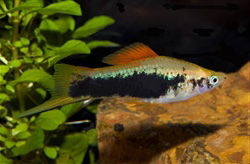


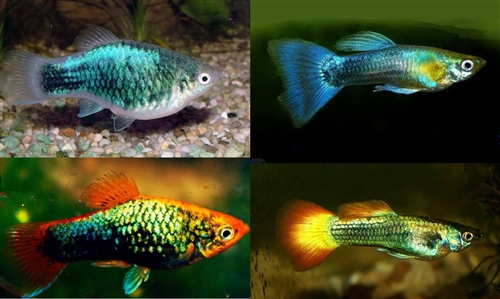
Now, this half black is so persistent and dominant that one started to wonder if there was not going on something more about it. But then what? Some saw the similarities with the black platy , and indeed: the distribu-tion of the color cells, the gloss stripe on the upper body, and the combina-tion with other colors shows very strong similarities. (see photo above). But crossings between guppies and platys are not really possible: they are cousins, but anatomicly it is not possible (guppies, endlers and black mol-lies belong to the subgenus Poecilia , while platies and swordsmen belong to the subgenus Xiphophorus ). In contrast to crosses between platys and xipho's which are more closely related, and which give the black (tuxedo) and the red (tuxedo) xipho as result( but which are less streamlined than the original "white" xipho and more stocky like a platy) (see photos top left).
What about artificial insemination: was that already possible at that time? Probably not, but doubts arise when one observes how far some enthu-siasts drift with their hobby: for example, placing guppies on the "opera-tion table" to update their fins (whether this is to stop fin rot, to let (older) fish swim better, or to trim the caudal fins perfectly).
Anyway, important in all of this, is the fact that with that snakeskin and that halfblack , lay on the base of countless "modern" guppy strains, that have been bred since the 80's. Especially the somewhat weird metalhead from the first, and the Moscow (blue, green, purple, ...) from the second. What strikes me here - and what I immediately consider my personal contribution to the guppy story - is that one either goes too scientifically by giving each new variation a different gene name, or that one are either hiding himself too much behind those famous color cells when the guppy-story starts to show gaps. Ultimately, those color cells only do what the genes dictate, so they have only a secondary significance.
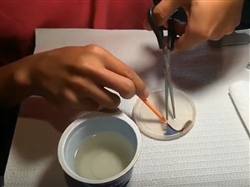


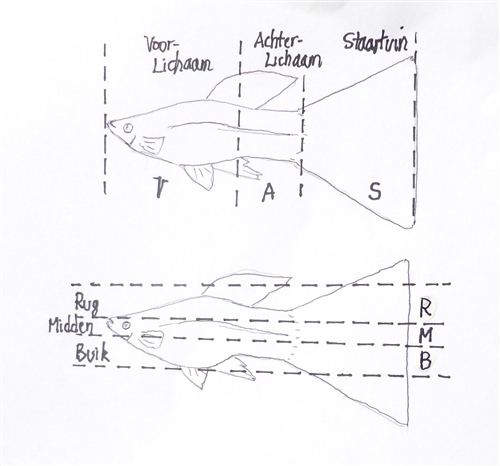

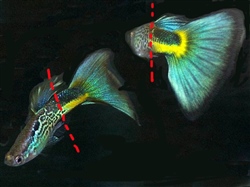
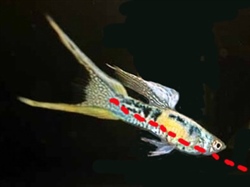

For example, if I compare the Moscow blue with the blue delta and blue veil that I grew in my youth, a clear difference stands out. However I tried my best to get the blue triangle as pure blue as possible, there were always so many variables in the game that I could never, ever achieve the result of a Moscow blue. There were always some color spots, stripes or minimal suspicions of other colors visible on the body or on the caudal fin.
One can be call the Moscow a mutation , but this is just a label and does not explain anything substantial. In my opinion, two principles work here. First, the "open" genetic structure is fixed to a fixed pattern . The gene configuration remains constant WITHIN this pattern, and no other genes can occupy this place, or disrupt this chain . The pattern stays and remains identical copied . And secondly: this happens, via the locations already mentioned by me.
This can be established on the basis of two more facts from breeding PRACTICE. First, all these mutations occur in a vertical or (and) horizon-tal segmentation . Some cover half the body (front or back body); others cover the upper or lower body. (see figure above central). Second, essen-tially failed breeding results, which combine two mismatched colors or markings WITHIN these zones, prove not only the existence of such zones, but also the "sticking" that takes place in the "free zone". I have added a number of wrong combinations as illustrations of this, with the line drawn at the zone-boundaries.
Ultimately, this gives us a more transparent and simpler system to organi-ze the different guppy strains and to understand the genetic mechanism behind it. Because thus one can recognize patterns , which relate to the entire body of the guppy (plain, snakeskin, vienna, moscow, ...), and patterns that are horizontally segmented (grass, neon tetra stripe, zigzag line, glossy stripe on the back, acanthus motif, .....); and also patterns that are segmented vertically (metal head, half black, japan blue, zebra or tiger, .....).
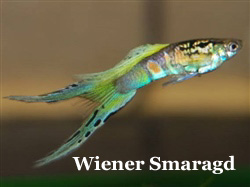


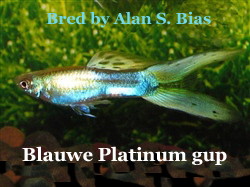
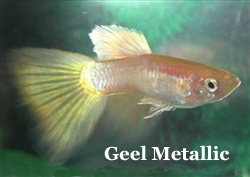
The patterns over the whole body are the most evident, natural and har-monious, because there is a unity in terms of color and drawing. This is where the story of the color cells fit in that makelike jackets, in different transparent or opaque layers above and below each other, and provide a dazzling spectacle, which turn a guppy into a living gem. The properties blond, gold, metal, silver and platinum can also be included in this be-cause they lay a color tone in a certain layer. And the properties albino, blue and margenta as well, but in the opposite sense: they do not add a new layer, but delete previously existing layer(s) to a minimum.
Those "jackets" are layers of skin. The guppy skin is constructed in 3D : no less than 3 layers that lie on top of each other and ensure a translucent interplay, mixing or covering and masking of each other.
The top layer consists of yellow and red color cells, and functions as an boulter and filtering zone: yellow and red are "recognized", capted and reflected (and we see yellow and red in the guppy), and the other colors of the spectrum are let through to the next layer.
This second layer consists of iridescent color cells, and functions as a re-flection zone: the colors white and blue are in turn recognized and reflec-ted, with a certain quality of gloss : from matt , over silver-ish or metallic, up to and including gold-ish (= blond). Here is an example of how this works in concrete terms: a yellow guppy with a strongly iridescent interlayer, has a yellow-metallic appearance. A yellow guppy with white color cells instead of black color cells in the third layer (see below) looks dull yellow. And full platinum albino guppies ap-pear translucent white with a yellowish glow. What applies to yellow, of course also applies to the other colors.
Because the third and deepest layer consists of black color cells, and functions as an absoption and background layer: what was not processed by specific color cells in the top two layers is captured here. If that layer is absent , these colors are not reflected but absorbed, which can cause dull-ness and lack of intensity in the colors (see photo on the left). After all, the background or decor for the colors is missing and the mixed colors that are formed are pale in intensity: dirty green, dirty purple, dirty red, .... I already have this. mentioned in Part 2 on the overlap of color locations, but this is the "technical explanation" of this. The loss of color intensity upon elimination of black (e color cells) is a frequent problem in the monochro-me guppy culture. Finally, two specials about this third layer: black cells can be replaced by white color cells, or by gray diffuse color cells in the Moscow types .
Some varieties make an outer fourth layer, an "overcoat" in the fins: as in the gloss of the Stoerzbach strain and HB types.
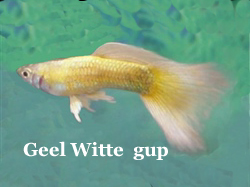
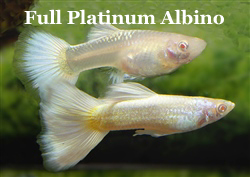
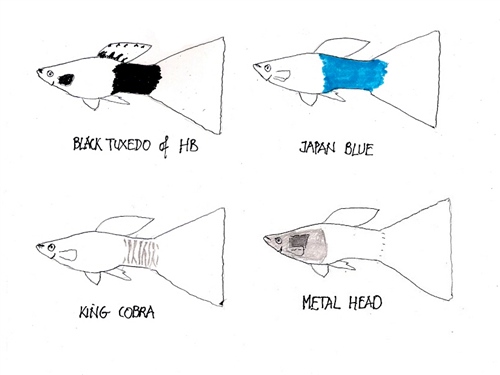
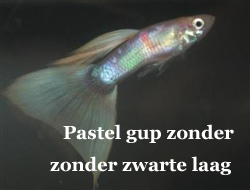
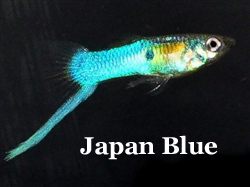
We have come to the patterns that are vertically segmented : in the forebody like the metalhead ; in the rear body such as the Japan blue and the zebra or tiger stripes (King Cobra); and finally also in the caudal fin like the flame pattern .
The metalhead was bred from the snakeskin strain by selecting. And in two different ways. Some snakeskins have a dark blue spot in the fore-body (stage 1), which becomes larger and deeper in color when aroused (when measuring strength with other males or when spawning the females). This was sometimes also called the "the blue bandit mark", and is the hallmark of the Grass Galaxy strains bred from it. By cultivating this trait further, it was possible to make this spot grow bigger and bigger (phase 2), until the entire front body was covered with it (phase 3). The metalheads that were obtained by crossing Moscow blue with Snakeskins prove that it can be done differently (but that required a crossing-over accident).
Now personally I think a metalhead is a rather artificial and not very beau-tiful guppy: he looks a bit like the product of a child's carving and pasting work. Especially in the gup strains that are then derived from it. The Red Pingu , for example, looks more like a gup hastily put on pajama pants. As I have already mentioned, both Japan Blue and Metalhead might be very practical strains for growers because they remain fairly constant, with limited variability in the "free" (= unfixed part). But at the same time they are like a tricky weed that one cannot remove from his garden: once they have made their appearance, it is very difficult to get it out of his guppy breeding. Getting rid of all his fish and starting from scratch may turn out to be the only working option.
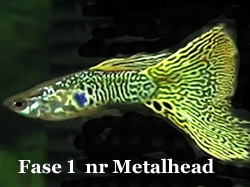
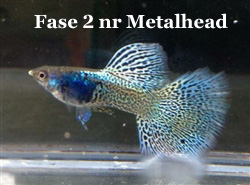
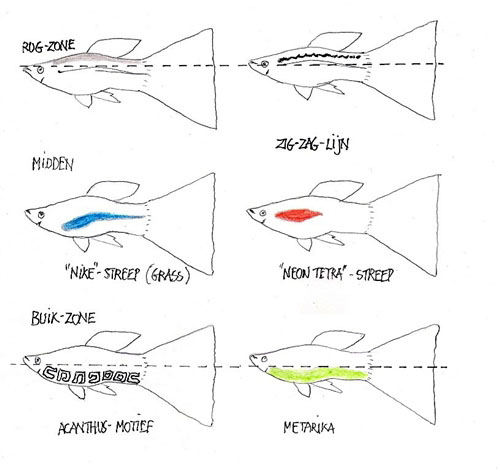
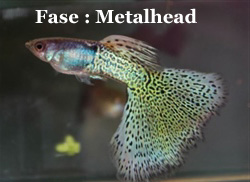
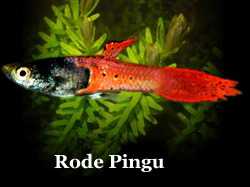

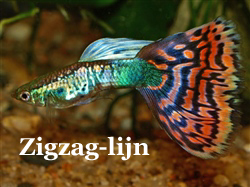
Finally, there are the patterns that are horizontally segmented , which is adapted to the streamlined body of a fish. Three segments: one on the back area like a stripe in a specific color; such as a zigzag line (whether or not accompanied by a row of color spots parallel above or (and) below). One in the mid-body like the blue Nike stripe on the Grass trunks, or a Neon Tetra stripe . And also one in the belly area, such as in a certain color - called Matarika , or like the Acanthus motif . The last appeared when the Snakeskin strain was refined, where the pattern reminds me of the stylized motifs on Greek columns.
These horizontal markings and colors appear more natural than the verti-cal segments, as they follow the swim direction of the fish, as well as the shape of the gup body around the lateral line or lateral line . They are also less rigid as a pattern, and have enough variability and leeway to allow changes in the culture.
The Endlers in particular have mainly horizontal segmentation, which has resulted in many hybrids between guppies and Endlers.

